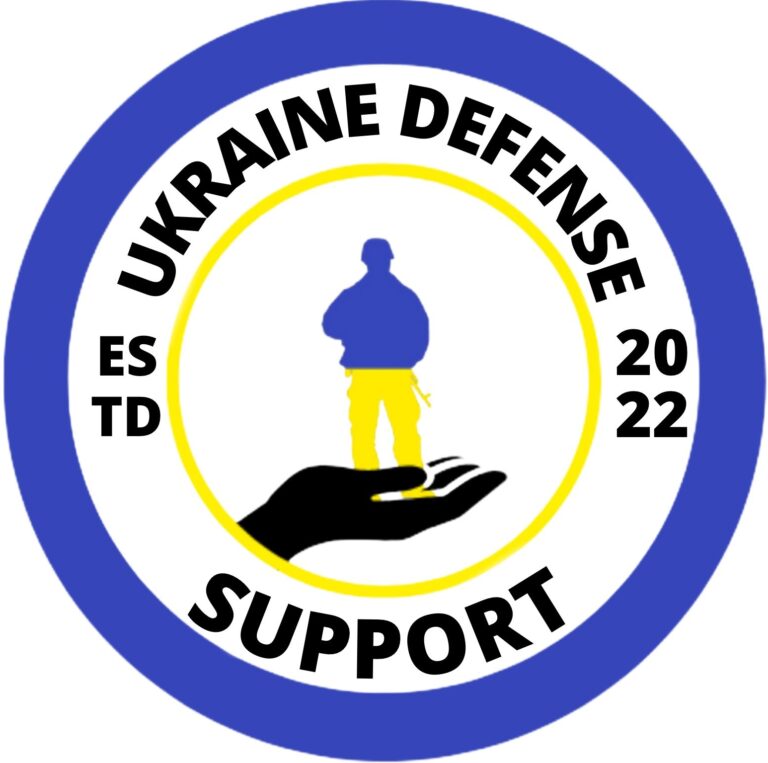Purpose
This guide has been created to assist the purchase, modification, and delivery of night vision optical devices to Ukraine’s military. It’s written for the perspective of a civilian, US-based purchaser, but should be applicable to purchasing night vision anywhere.
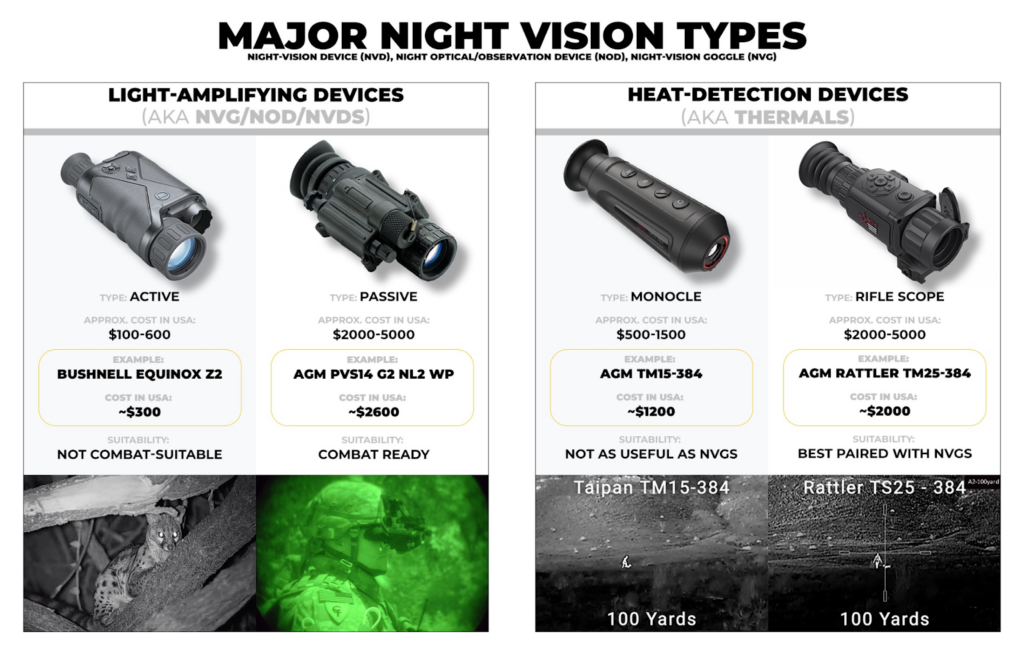
Introduction
Chapter 1 of this guide will help explain the intricacies of researching and purchasing night observation devices (NODs) and night vision devices (NVGs) for a person who has no idea what these terms mean. What are ‘tubes’? Which generation device do you need? What is the difference between ‘night vision’ and ‘thermal vision’? These questions and more will be covered.
Chapter 2 talks about accessories, their uses, and why you should consider them when making your purchase. Chapter 3 is a discussion about ITAR/EAR, and why you should consider these when exporting equipment to Ukraine.
The final chapters contain assorted resources and charts for your use. Who to contact, where to look for pricing, and so on.
We hope that this guide will inform your purchase of these devices now and in the future.
Слава Україні!
Chapter 1: Types of Night Vision Devices
Night Vision vs. Thermal Vision
The primary difference between night vision and thermal vision is how the image is enhanced and what can be seen through each device. Although the term “night vision” can be used to refer to both types, in military usage it is typically only used to refer to light-amplification devices, while the word “thermal” refers to heat detecting devices.
Both types of vision enhancement serve their purposes on the battlefield, but each has pros and cons that must be considered prior to purchase. For this reason, light-amplifying night vision devices (commonly called “NVGs” or “Night Vision Goggles”, even if not really goggles) are used for typical nighttime soldier tasks such as patrolling or driving, and are often paired with IR laser illuminators, while thermal optics are often used for different purposes such as spotting ambushes or mines. Thermal scopes (as opposed to helmet-mounted monocles) are mounted to a weapon and are usually used to spot and shoot enemy soldiers at nighttime. Your soldier can potentially switch between NVGs and thermals (or use both) depending on the situation and use case.
Night Vision Technical Details
Night Vision Devices (NVDs) are typically called “NVGs” or “NODS” (night optical/observation device) by the US military so we will use the term “NVGs” in this guide. They generally use chemical means similar to a glow-in-the-dark watchface. Incoming light excites a phosphorescent coating inside an ‘amplification tube’, giving energy to the coating and causing it to put off more light on its own. A modern NVG is very good at amplifying weak visible light sources, but this means that NVGs require at least some ambient light in order to operate. If there is no ambient light to amplify, such as in a sealed bunker underground, the NVG does not work very well or at all.
Additionally, because NVGs use a chemical process to amplify light sources, the internal amplification tubes physically wear out and must be replaced periodically. Over time, the phosphorescent coating will stop glowing as brightly, or as accurately, reducing image clarity gradually, causing eye strain. Being exposed to very bright light sources wears out the tubes faster. For that reason, “auto-gating” NVGs are recommended, and will be discussed further in this chapter.
Generations
NVGs are generally organized by their generation number. A Gen 3 device is much newer technology than a Gen 1 device, for example, and will be more expensive as a result. Newer generations usually mean better image quality, longer serviceable lifespans, smaller size and/or lighter weight. Gen 2 and Gen 3 devices are the standard used on the battlefield right now.
Gen 1 was first developed around the 1960s. Although it was a giant step forward at the time, these devices today are considered entry-level at best, useful only for civilian light duty at short ranges (100 yards or less). At worst, they are collector’s items. Several amplification tubes are used in series, each amplifying the last. This causes an effect called ‘blooming’, similar to the degradation seen when making a photocopy of a photocopy. Any artifacts or blemishes in the tubes are therefore greatly amplified. To be most useful, a Gen 1 device is often assisted by an external IR light source, a major drawback. Any IR light on a modern battlefield will be visible from miles away by any enemies with their own night vision, giving away one’s position and resulting in mission compromise/death. A Gen 1 device is bulky, short-range, and low-resolution. While fine for hunting or search and rescue and typically very affordable, Gen 0 (requiring IR light assistance) and Gen 1 devices are not appropriate for modern combat.
Gen 2 is more modern, and is used on battlefields today. Gen 2 devices add a ‘micro-channel plate’ (MCP) that further discriminates and amplifies incoming light for increased clarity, especially at the edges of the lens. The MCP also allows fewer amplification tubes to be used, reducing the physical size and weight considerably. Gen 2 devices are still highly capable and suitable for use on modern battlefields.
Gen 3 is the latest generation, used by modern militaries such as the United States. Gen 3 devices upgrade to a gallium arsenide photocathode in addition to the normal amplification tubes and MCP which produces significantly more accurate visible amplification than previous generations, including in the near-infrared spectrum. To further increase clarity and reduce blooming, a chemical film is applied to the MCP. This film helps to discriminate incoming light sources, allowing for more accurate reproduction of the source image without degradation.
With Gen 3 devices, you can expect a longer useful range than Gen 2, depending on the device standard and manufacturer. Image clarity and brightness is greatly increased over Gen 2, and eye strain is significantly reduced. Gen 3 devices are a further refinement of Gen 2 and typically cost 50% more.
| Gen 0 | Gen 1 | Gen 2 | Gen 3 | |
| Price | $200-500 | $500-1000 | $2000-4000 | $3500-6000 |
| Lifespan | 500 hours | 500 hours | 1000-5000 hours | 10,000 hours |
| Design | Usually digital | Digital or tube | Tube | Tube |
| IR Light Required | Active | Active | Active/passive | Passive |
| Green/white phosphor | GP | GP | GP/WP | GP/WP |
| Eye-strain | High | High | Medium | Low |
| Usage | Not combat suitable | Not combat suitable | Combat suitable | Combat suitable |
Light-amplifying NVG quick reference chart
Passive vs. Active
When referring to NVGs, it’s important to know the difference between “active” and “passive”. Passive operation is being able to operate without the use of external light sources. Passive operation is preferred for many reasons. Most importantly because external light sources can be seen by anyone with a NVG, including enemies. When referring to NVGs, passive is much better than active. If a NVG specifies that it is active only, it is not suitable for combat operations.
Auto-Gate
Gen 3 devices, and less commonly Gen 2, can come with an ‘auto-gating’ feature. This is essentially a shutter that opens and closes multiple times per second to ‘gate’ the amount of light reaching the photosensors. While normally not very noticeable to the user, the gate automatically controls how much light goes into the device, preventing damage to the internal photoelements from bright sources. Bright light sources will overwhelm the amplification tube(s) and reduce operating hours significantly. The auto-gate prevents damage to the internal parts of the NVG.
Auto-Gain
‘Gain’ is the amount of amplification supplied by the tube to the user’s eyes. Gain is a variable number, depending on the settings of the device. Some devices have no gain control, others are manual gain only, and still others can come with an auto-gain in addition to manual gain controls. Too much gain can result in distortion of the image or ‘night-blindness’ from the user seeing too much light. High-quality devices may come with an ‘auto-gain’ feature that automatically adjusts gain based on ambient light levels. Auto-gain, unlike auto-gating, is a feature to help the user by controlling the amplification of light to prevent night- and flash-blindness by turning the gain down.

Image Intensification/Amplification Tubes
Also just called ‘tubes’. Both Gen 2 and Gen 3 devices come with either green phosphor (GP) or white phosphor (WP) tubes. GP is the standard, but WP provides better image clarity, lower eye strain, and longer lifespan at increased cost. Either will work, and both are in military service today, but WP is generally preferred by the end user.
Additional Specs and Info
FOM vs Gain/Luminescence is a technical comparison not usually relevant to most buyers. Just make sure to only buy NVGs with FOM greater than 1400. Aim for a min of 1600. 1800 is great. 2000 is golden.
As far as quality control L1/L2/L3, L1 and L2 are fine but try to stay away from 3 (the worst). L3 likely means spots or blemishes on the lens.
Be sure to thoroughly test any NVGs before delivery to any military units. They commonly have problems.
Why the PVS-14 NVG is the industry standard
The PVS-14 NVG is a worldwide standard night vision device for many reasons:
|
|
|
|
|
|
|
|
|
|
AGM is a well-known major supplier of PVS-14 and other night vision:
Although the link is on Amazon for easy reference, we typically buy these directly from the manufacturer AGM for $2,000 plus helmet mounts ($200) so a total of $2,200, then courier them to Ukraine.
When buying tube-based night vision like PVS14s, it is important to look at the generation level (we usually buy gen 2, gen 3 is much more expensive and ITAR restricted) and quality control (you want NL1 or NL2, not NL3).
Thermal Vision
Even if the night is literally pitch black, it’s only dark in the visible spectrum. Heat sources still emanate non-visible infrared signatures that can be detected even in total darkness. Thermal vision is a purely digital process that uses a camera sensor much like the one found on a cell phone, except it has been designed to see infrared sources rather than light in the visible spectrum. Unlike traditional night vision, there is no periodic replacement needed for a thermal device’s IR sensor.
Thermal optics do not work through glass, therefore they are useless for driving or seeing through building windows. Glass is a poor conductor of heat, so distinct IR signatures do not transfer through like visible light does. For this reason, thermal imaging often works best when paired with night vision.
Although we would like to be able to provide the most advanced thermal vision to every soldier, money is an issue that we all have. Good thermal vision is necessarily more expensive than comparably useful night vision. While inexpensive options may be found, the major difference is range and digital resolution. Cheap $500 thermals may work to help spot drones and as NVG replacements for short (<100m) range, but more expensive (~$1200) units allow much father range usage. Better still are thermal rifle scopes, especially when paired with helmet mounted NVGs like PVS-14s, allowing soldiers to drive or patrol almost as well as during the day with the NVGs, then use the rifle-mounted thermal scope to spot ambushes and enemy soldiers at long range and “turn orks into sunflowers” long before the enemy can even see our boys through their own NVGs.
Sensor Resolution
Thermal imaging generally comes with a sensor resolution (also known as a ‘core resolution’) noted as either ‘320’ or ‘640’. European models may use ‘384’ instead of ‘320’, but the two are comparable for our purposes. This refers to the pixel resolution of the camera sensor, either 320×240 (384×288) or 640×480. Keep in mind that this is the resolution of the sensor itself.
Display Resolution
There may be a second, larger resolution noted, but this is for the display screen that the user looks at (the eyepiece). 1024×768 is a good resolution for the display screen. Smaller resolutions can cause a muddy or unclear image on the display, reducing combat effectiveness.
Detection Range
Detection range refers to the most extreme distance at which the user may be able to detect a thermal difference between ambient temperature and a target. The further away the object, the more it blends in with the surrounding IR. This is a limitation of the sensor. More sensitive or discriminatory thermal imagers, such as a Pulsar Thermion, can reliably detect past 2000 yards.
Monocles vs Weapon(rail)-Mounted Thermals
Thermal monocles are typically not as useful as regular NVGs. They can be used for different tasks such as detecting ambushes and mines but cannot be used while driving (they do not work through glass) and are tiring to use while walking. The most typical monocle supplied is the AGM TM15-384 ($1200 on Amazon). A typically better use of thermal technology is weapon scopes. There are many options.
Thermal scope accessories
The weapon mount is critical. Here is an example of a trusted option (≈$230):
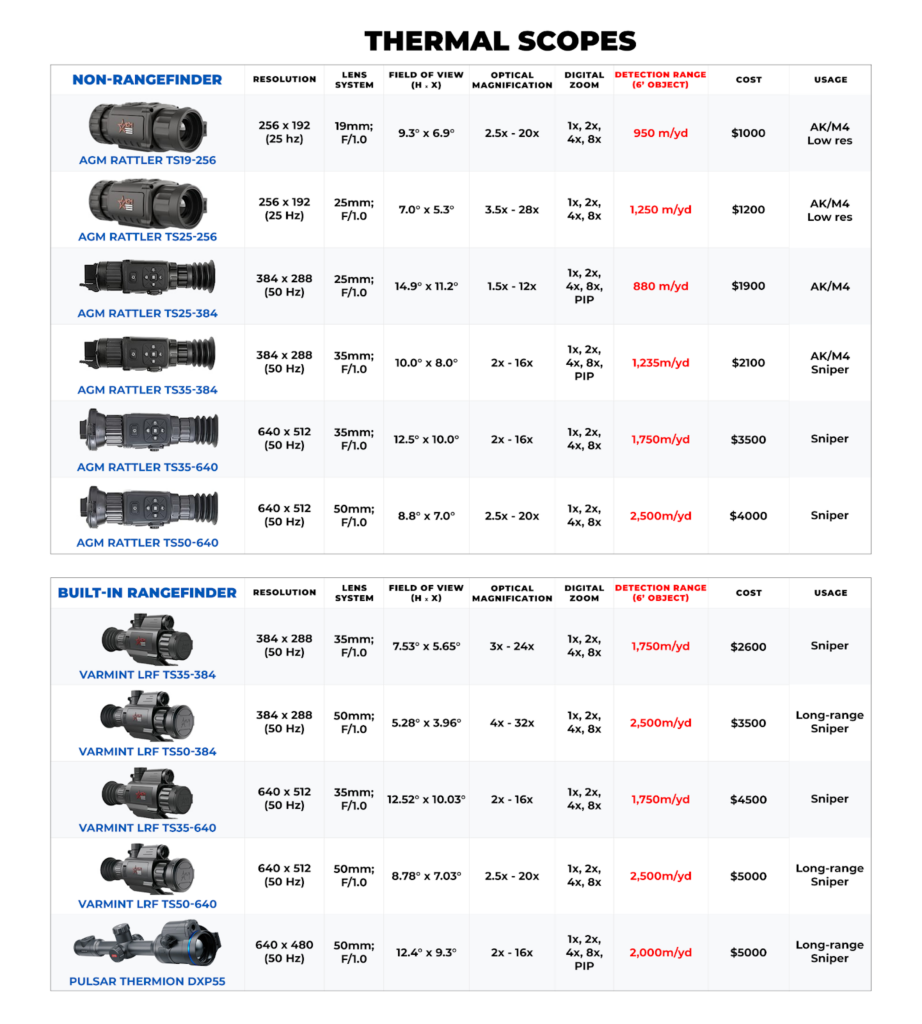
Chapter 2: Accessories
Lasers & Illuminators
Laser IR illuminators are a critical aid to shooting in the dark. The IR laser is invisible to the naked eye but shows up as a strong beam of light to NVGs. Note that they do not work with thermals.
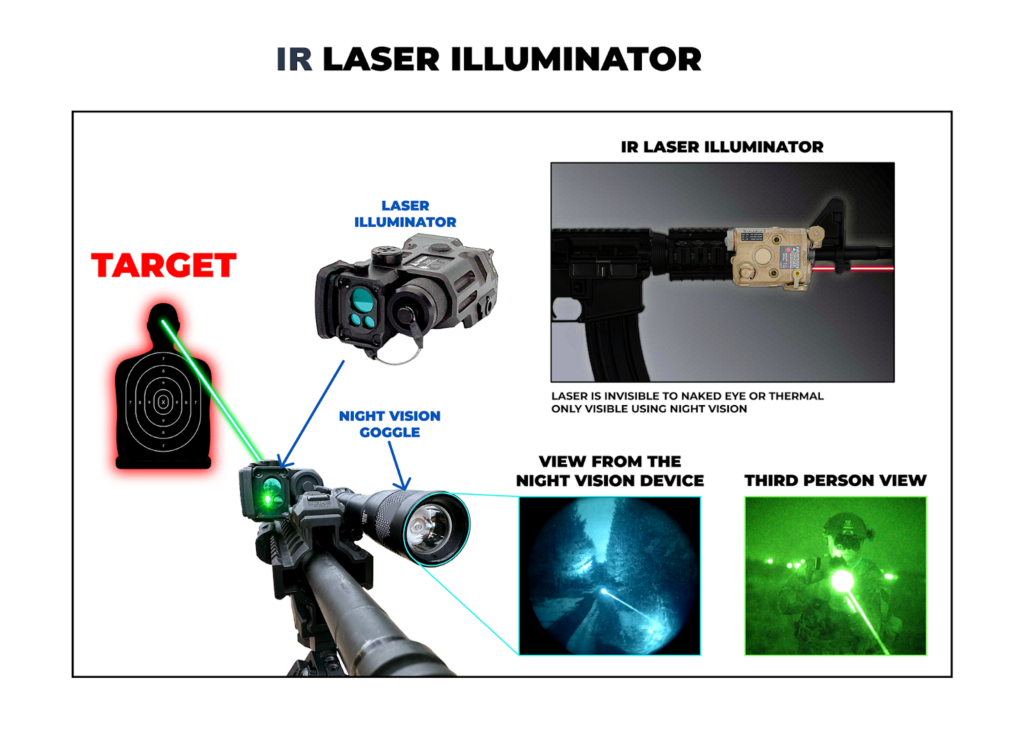
- Mil Spec PEQ15 IR laser illuminators are around $2000:
- This Airsoft version is hardened, waterproof and $400 but backordered for weeks.
- This Airsoft version is not hardened, reasonably watertight, and works for $50. We have used it on our own rifles and sent 20 to the front where it’s been popular. None have broken, but it is important to point out that it is a cheap clone.
An ideal, cost-effective mixture for a 12 man squad might be 12 PVS-14s, all with PEQ15s and 3 designated snipers having thermal scopes.
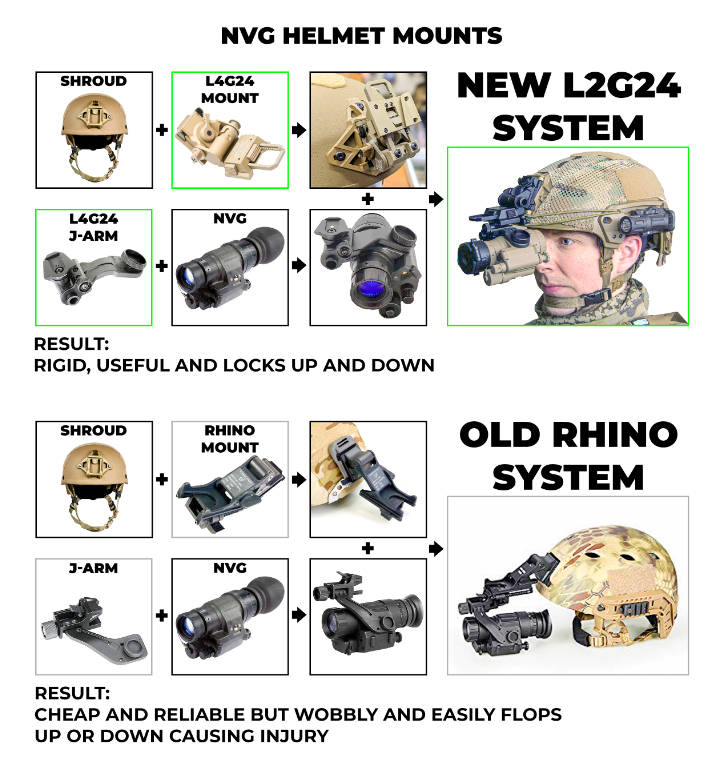
Helmet Mounts
Helmet mounts are critical for soldiers to be able to conduct normal military operations without having to hold the monocle in one hand. Imagine having to hold a monocle while driving or patrolling. We have found high quality, relatively inexpensive helmet mounts.
Examples of mounts for sale in US:
- Gexmil CNC PVS15/18 Night Vision Goggles Mount for L4G24 NVG Metal Helmet Mount
- Canis LATRANS PVS 14 Mount Night Vision Goggles NVG Mount Dovetail J Arm Rhino Mount Compatible with All Models of PVS-14
Chapter 3: Buying
NVGs and thermals can be bought in the US, in Western Europe or Ukraine itself.
- Buying in the US
- Most US-based groups buy NVGs here and courier them to Ukraine. Items may be bought quickly for a premium price through Amazon. Most groups have relationships with dealers to get preferred pricing. Contact us for details. We do not recommend mailing via Meest although some people do.
- Buying in Western Europe
- Prices in Western Europe are 30-50% higher but the time is faster and less concerned with oversight. Poland has a network of ecommerce stores that have decent prices but most do not deliver to Ukraine. Contact us for ways to make this work. Bear in mind that ITAR regulations still technically apply for US citizens.
- Buying in Ukraine
- Ukraine has many established gun and military stores that sell NVGs, typically for a 50-100% increase in price over US-supplied items. When time is critical, buying in Ukraine may be the best option.
- Buying in China
- Chinese-made NVGs are typically active, not passive, and therefore not combat-suitable. Eventually Chinese manufacturers may produce a product comparable to the PVS-14, but they have not yet.
Chapter 4: ITAR and EAR Compliance
The export and international transfer of the night vision devices described above are regulated for US persons and entities by either ITAR or EAR, depending on their classification.
ITAR (International Traffic in Arms Regulations) is US legislation restricting the export of certain defense-related items. This includes actual firearms, firearms parts, ammunition, certain vision enhancement devices, flash suppressors, and military vehicles. The U.S. Department of State is responsible for implementing and enforcing ITAR, with advice from the Dept. of Defense.
EAR (Export Administration Regulations) is a set of United States government regulations on the export and import of most commercial items, including civilian/military “dual-use” items which includes some of the less leading-edge grades of night vision and thermal vision. The U.S. Department of Commerce is responsible for implementing and enforcing EAR, with advice from the Depts of State and Defense.
US Dept. of State ITAR rules tend to be strict, whereas Dept. of Commerce EAR rules are more flexible.
To give an example, Gen 3 PVS 14s and some thermal optics with high resolution are handled by ITAR, whereas Gen 1-2 PVS 14 and lower-resolution thermals resolution are handled by EAR. What is the critical thermal resolution? That depends who you ask.
Light-Amplification Device Legal Rules, by Generation
| Gen 0 | Gen 1 | Gen 2 | Gen 3 | |
| Usage | Not combat suitable | Not combat suitable | Combat suitable | Combat suitable |
| Restriction | EAR | EAR | EAR | ITAR |
Rules for Light-Amplification Devices
Gen 1-2 NVGs having FOM (“Figure Of Merit” or resolution and Signal to Noise ratio) rating (resolution * SNR) at or below a specified limit (<=1600) can be purchased by US persons & orgs overseas and transferred to Ukraine without needing an ITAR license. EAR compliance is still required.
Gen 3 NVGs or any NVG with FOM over 1600 fall under the more restrictive ITAR regulations, and so technically require license approval from the US State Dept. to transfer outside the US, even if purchasing units already overseas.
ITAR requirements from official State Dept Regulations:
Rules for Thermal-Amplification Devices
Similarly, most thermal vision devices with sensor resolutions of 384 x 288 pixels and under fall under the less restrictive EAR regs and so can be purchased by US persons & orgs overseas and transferred to Ukraine without needing a license. Acquiring them from within the US and then exporting them does technically require a license to stay within the regulations in most cases, as does the purchase of most thermal vision devices with sensor resolutions higher than 384 x 288 pixels, or any that also contain a built-in laser rangefinder.
Conclusions
Most larger orgs are using licenses to export items by working with ITAR/EAR experts, while many, many smaller orgs appear to be conveniently ignoring the legalities and simply couriering the items from the US to Ukraine. While we do not recommend this approach, no orgs appear to have been penalized so far for this shortcut.
An ITAR/EAR licensed professional can provide specific advice for your individual situation. We have a network of professionals we can direct you to.
Note that ITAR compliance to ship to Ukraine typically requires an official letter from a Ukrainian unit commander or registered Ukrainian NGO.
Note that non-US citizens are not supposed to purchase ITAR regulated items such as Gen 3 PVS-14. Only residents (Green card holders) and citizens are supposed to.
Chapter 4: Additional Resources
For assistance providing night vision devices, thermals or accessories to front line Ukrainian military units, contact Ukraine Defense Support at [email protected]. We have an extensive network of manufacturer contacts, ITAR/EAR experts, couriers and distribution networks within Ukraine.
- Project Sirin
- Most other groups supporting the Ukrainian military provide night vision. Examples:
